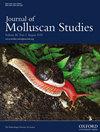日本隐斑藻的分子调查揭示了太平洋西北部的神秘谱系
IF 1.2
4区 生物学
Q2 MARINE & FRESHWATER BIOLOGY
引用次数: 0
摘要
石栖属隐藻(Cryptoplax)广泛分布于印度-太平洋,延伸至南澳大利亚和西北太平洋(NWP),共有17种。其中,日本隐虫(Cryptoplax japonica)常见于NWP的潮间带和潮下岩石基质上,而丙隐虫(C. proproor)因其隐蔽的潮下栖息地和分布范围而很少见到。本研究利用线粒体基因细胞色素c氧化酶亚基I (COI)的DNA序列,对韩国和日本沿海地区24个采样点的93个粳稻种群进行了遗传多样性调查。单倍型网络和COI序列的系统发育分析显示,粳稻有两个高度分化的遗传谱系,它们之间存在较大的双遗传距离(10.62%),这相当于这两个谱系(a或B)中的任何一个谱系与共同发生的丙酸稻的遗传差异。除COI序列外,3个世系16S rDNA的平均序列差异在2.0 ~ 3.3%之间。与这一深层序列差异相反,对齿圈、腰带和关节着色的形态学检查,以及使用主成分分析和线性判别分析对壳测量的形态计量学分析显示,两个粳米系之间没有诊断差异。这两种不同的谱系在我们研究的大部分地区共同出现,没有形态差异,表明隐分化。从这些隐蔽物种的整个分布范围进行更广泛的采样,结合使用额外的分子标记,可以阐明它们分化的机制。本文章由计算机程序翻译,如有差异,请以英文原文为准。
Molecular survey of Cryptoplax japonica (Polyplacophora: Cryptoplacidae) reveals cryptic lineages in the northwestern Pacific
The chiton genus Cryptoplax is widely distributed in the Indo-Pacific, extending to southern Australia and the northwestern Pacific (NWP), with 17 recognized species. Among these species, Cryptoplax japonica is commonly found on rocky intertidal and subtidal substrates in the NWP, whereas another species, C. propior, is rarely seen because of its cryptic subtidal habitat and limited distribution. In this study, we surveyed the genetic diversity of C. japonica populations based on 93 individuals from 24 sampling sites along the Korean and Japanese coastlines, including the type locality, using DNA sequences of the mitochondrial gene cytochrome c oxidase subunit I (COI). Haplotype network and phylogenetic analyses of COI sequences revealed two highly divergent genetic lineages of C. japonica separated by a large pairwise genetic distance (10.62%), which was comparable to the genetic difference when either of these two lineages (A or B) is compared with the co-occurring C. propior. In addition to COI sequences, average sequence divergence in 16S rDNA between these three lineages ranged from 2.0 to 3.3%. In contrast to this deep sequence divergence, both morphological examination of radula, girdle and articulamentum colouring, and morphometric analyses of shell measurements using principal component analysis and linear discriminant analysis revealed no diagnostic differences between the two C. japonica lineages. The co-occurrence of these two divergent lineages within most of our studied area, with no morphological differences, indicates cryptic divergence. More extensive sampling from the entire distributional ranges of these cryptic species, in combination with the use of additional molecular markers could shed light on the mechanisms underlying their divergence.
求助全文
通过发布文献求助,成功后即可免费获取论文全文。
去求助
来源期刊

Journal of Molluscan Studies
生物-动物学
CiteScore
3.00
自引率
8.30%
发文量
36
审稿时长
3 months
期刊介绍:
The Journal of Molluscan Studies accepts papers on all aspects of the study of molluscs. These include systematics, molecular genetics, palaeontology, ecology, evolution, and physiology. Where the topic is in a specialized field (e.g. parasitology, neurobiology, biochemistry, molecular biology), submissions will still be accepted as long as the mollusc is the principal focus of the study, and not incidental or simply a convenient experimental animal. Papers with a focus on fisheries biology, aquaculture, and control of molluscan pests will be accepted only if they include significant advances in molluscan biology. While systematic papers are encouraged, descriptions of single new taxa will only be considered if they include some ‘added value’, for example in the form of new information on anatomy or distribution, or if they are presented in the context of a systematic revision or phylogenetic analysis of the group.
 求助内容:
求助内容: 应助结果提醒方式:
应助结果提醒方式:


